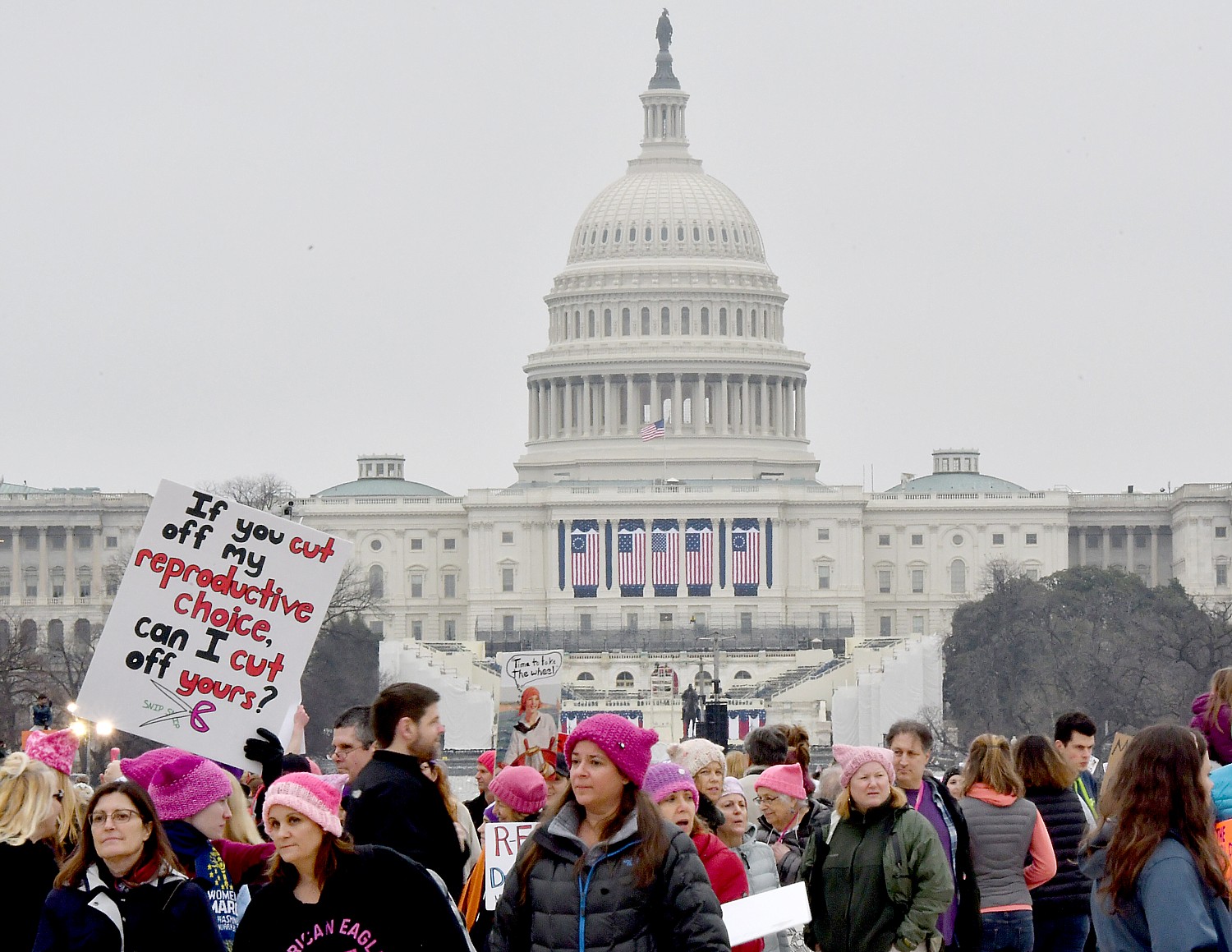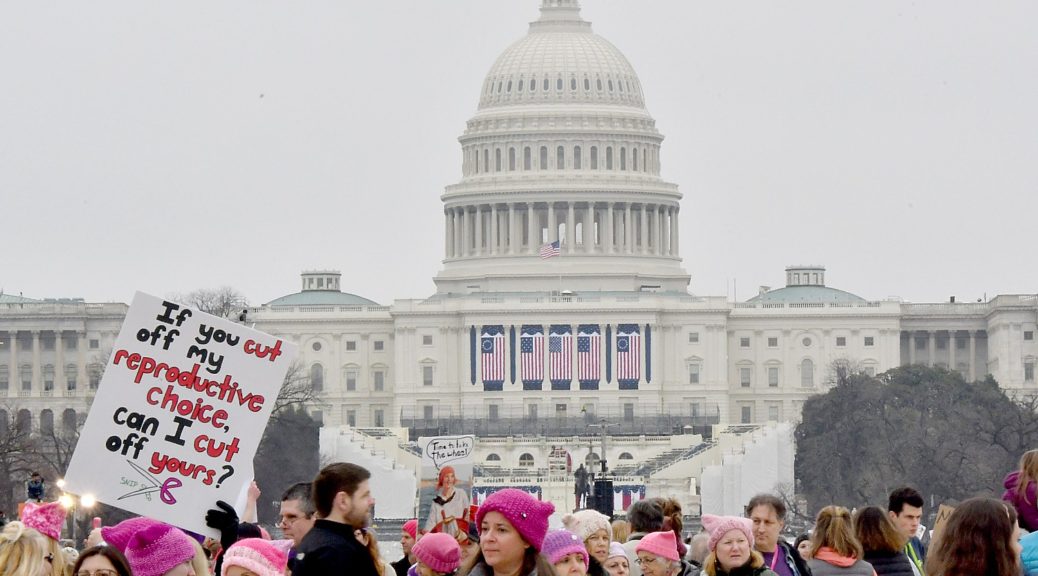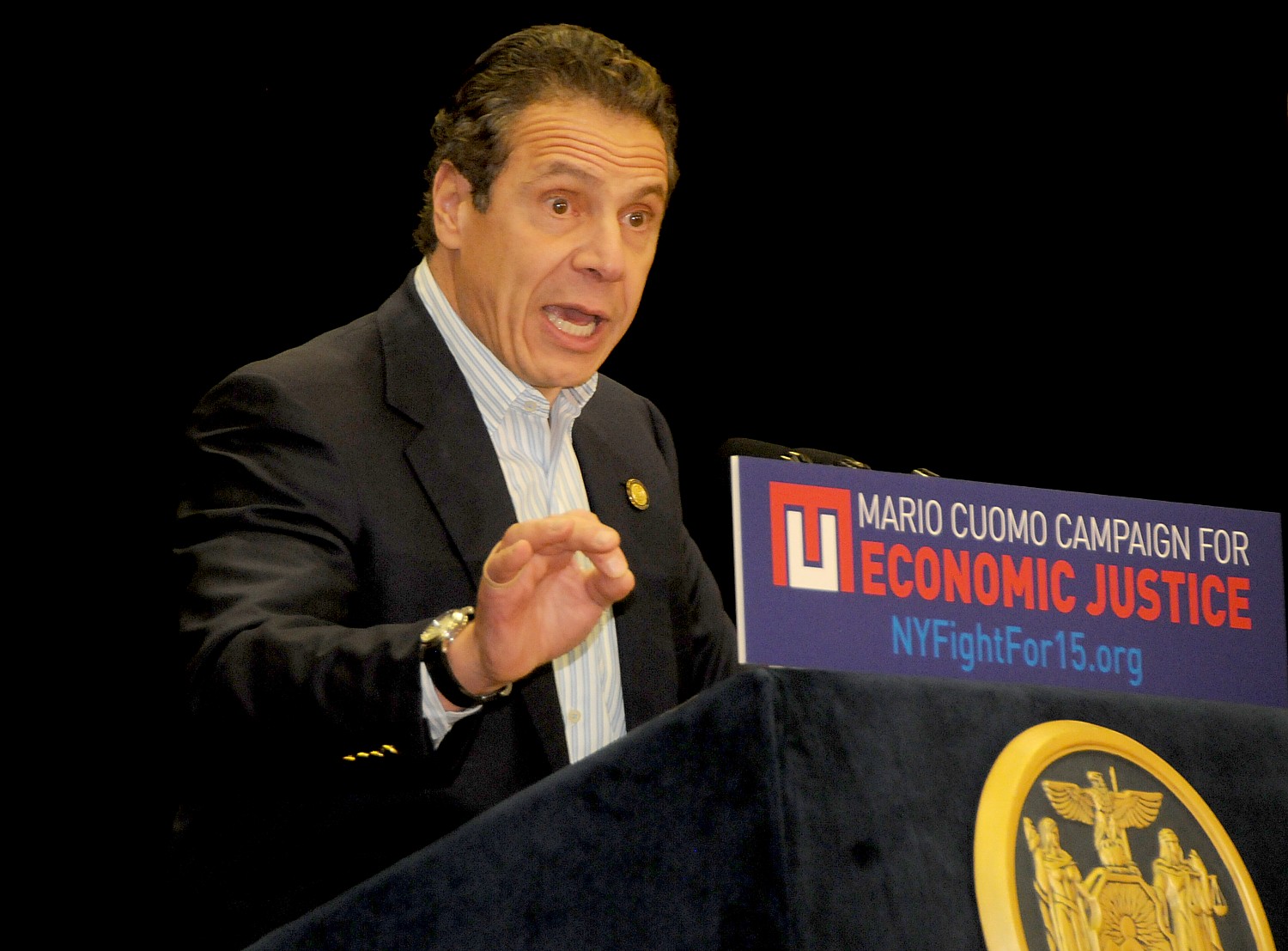
By Karen Rubin, News & Photo Features
For those women who flexed their liberated muscles by opposing Hillary Clinton (because after all, what did they have to lose?), two stories from this week stand out:
GOP Lawmaker Asks Why Men Should Pay for Prenatal Care
Judge resigns over rape trial comment: ‘Why couldn’t you just keep your knees together?’
Trump has not only set back American progress on every aspect of civil, environmental, economic and criminal justice a century to the Gilded Age, but threatens to do the same with women’s rights and standing in society. And I’m not just referring to the fact that he has made it okay to be a misogynistic, sexist, racist, xenophobic bit.
Hillary Clinton in her campaign noted that it isn’t just “attitude” or “culture” that propagates bias, but systemic reinforcement in the economy, the tax code, the courts, the law, and most especially health care and reproductive rights, that, more than anything else for all practical purposes keep women down and lacking power.
The Affordable Care Act (Obamacare), explicitly reversed those impediments, which allowed insurance companies to make women pay higher premiums for their pre-existing condition of being a woman.
The health care “reform” that Republicans are trying to ram through would not only restore that ability of insurance companies to charge women more so that they couldn’t actually afford prenatal care, or for that matter a delivery, or the necessary care for their infant, especially one that is born without all the advantages of its mother having had access to prenatal care, but they propose to defund Planned Parenthood, used by 4 million people (52 million visits a year), resulting in 551,000 fewer unintended pregnancies, and of course, they intend to end women’s reproductive rights altogether.
After the Women’s March on Washington the day after inauguration, which brought out millions across the US and the world, I proposed that women should strike to demonstrate how essential to the economy women were. On March 8, International Women’s Day, there was just such a strike, “A Day Without Women.” But as the big day approached, I realized it had to fail because women predominate in jobs that are life and death – nurses, teachers, home healthcare and daycare providers, legal services (the list goes on and on and on).
“My babies,” is how a Great Neck kindergarten teacher described her students during a school board hearing on the proposed bond, noting that there is a significant difference in learning readiness for children who come to kindergarten with or without having attended pre-K, which follows through throughout their elementary schooling. They don’t catch up. I am quite sure she was in her classroom teaching instead of joining the “Day Without Women” strike.
Moreover, unless a woman worked for a sympathetic boss, she likely could not afford to lose pay, and possibly her job.
Consequently, the full impact of women on the economy, and in society – that women comprise half of the entire paid labor force for the first time in history, mothers are now close to 50 percent of all primary breadwinners, and women drive 70 to 80 percent of all consumer purchasing – went unnoticed, and women as a political force were pretty much told to sit down and shut up, as Senate Majority Leader Mitch McConnell told Senator Elizabeth Warren.
But, as ever, Senator Warren expressed best why “women’s issues are economic issues” and how the system is rigged against them:
Women are the main breadwinners, or joint breadwinners, in two-thirds of the families in America, she said, but:
- Having a child is the single best predictor that a woman will end up in financial collapse.
- Single moms are more likely than any other group to file for bankruptcy – more likely than the elderly, more likely than divorced men, and more likely than people living in poor neighborhoods.
- Single moms who have been to college are actually 60% more likely to end up bankrupt than those with just a high school diploma.
“The deck has been stacked against working women and moms for years. And with the Republicans in charge, it’s getting worse – a lot worse.”
Warren noted:
Women struggle under the burden of student loan debt, child care costs that equal college tuition, make 78 cents to the dollar of her male colleague and can be fired just for asking what the guy down the hall makes (Republicans are blocking the Paycheck Fairness Act).
Mothers are 10 times more likely than fathers to take time off when their kids are sick, and 60% are not paid for that time off. Too many women fear losing their jobs because they are stuck having to choose between work or caring for someone they love. (Republicans won’t even let us have a vote on paid sick time and family leave, and Trump rolled back Obama’s executive orders on parental leave and overtime pay).
Two-thirds of minimum wage workers are women but the minimum wage hasn’t gotten a federal raise in seven years, and mothers of very young children disproportionately work low-wage jobs (Trump rolled back Obama’s executive order and Republicans have blocked every effort to raise it.).
Because women make less than men throughout their lifetimes, they receive, on average, about $4,000 less a year than men in Social Security benefits (as well as pensions). This really hurts because women are less likely to have other assets, so they rely more heavily on those Social Security checks to keep them out of poverty. Republicans still threaten to cut Social Security for women and families and raise the retirement age, while their health care plan would also increase the cost of having health care and likely toss off millions of women and children from any health care at all.
“Donald Trump was right about one thing: the game is rigged. It’s rigged for rich guys like Donald Trump. The system works great for those who can hire armies of lawyers and lobbyists, but it leaves women and families behind. A system in which Republicans work tirelessly to rip away health care from millions of women and defund Planned Parenthood health clinics, while giving away billions of dollars in subsidies to Big Oil. A system that cuts Head Start programs and NIH medical research, but protects tax breaks for billionaires and giant corporations,” Warren stated.
And no where is this “rigged system” more apparent than in the Trump/Ryan plan to repeal Obamacare and replace it with a plan that will strip health insurance from millions, raise the cost for women, for older people, for the poor and sick, in order to give the 400 richest Americans—who averaged incomes of $318 million in 2014—a tax cut of about $7 million a year, a windfall that they will happily reinvest in buying the election of candidates who will do their bidding. (Trump doesn’t pay taxes, so this wouldn’t benefit him.)
Indeed, as it turns out, there isn’t a single “Women’s Issue” but rather, a broad gamut of issues are central to women: climate change, nuclear nonproliferation, gun violence prevention, food, water and drug safety, education, workers rights, health care and public health; infrastructure and mass transportation; immigration rights, criminal justice reform, affordable housing. What is there about life that doesn’t concern women?
The fascinating thing about that ignorant lout who is unbelievably serving in Congress but can’t understand why a man should have to pay for prenatal care is that society has a collective interest in women’s health, and public health. If someone doesn’t go to the doctor and can’t afford to stay home from work, their communicable disease will spread. When people don’t go to the doctor for an early diagnosis, but only go when the condition becomes severe, society as a whole foots the bill for catastrophic care, and is deprived of that individual’s productivity.
Clearly, there should be a different sort of strike, one that would not require women to relinquish their work responsibilities: they should strike sex. Women are considered mere vessels to incubate an embryo (an elected official actually said that), a lesser person with fewer legal and political rights than a zygote. Women are singularly punished for having sex. Sex in Trump’s misogynistic RightWing America has come to mean enslavement. (And yes, I realize this sounds as crazy as Ben Carson, the neurosurgeon who has taken over Housing & Urban Development, who equated the slaves who were brought to the US in chains at the bottom of boats to “immigrants” with their high aspirations.)
John Oliver, in his summation of International Women’s Day on Sunday’s episode of Last Week Tonight, said: “Every year, the best way of gauging not just how far women have come, but perhaps how far they still have to go, is by watching powerful men around the world trip over their dicks while talking about the day.”
He highlighted Vladimir Putin, who told his nation, “Women give us life and perpetuate it in our children. We will do our utmost to surround our dear women with care and attention, so that they can smile more often.”
Women in Congress (still only 20%) wore white to Trump’s joint address, to symbolize the suffragettes of a century ago and show solidarity.
“We wear white to unite against any attempts by the Trump Administration to roll back the incredible progress women have made in the last century, and we will continue to support the advancement of all women,” Rep. Lois Frankel, D-Fla., the chair of the party’s Women’s Working Group, said in a statement.
See also:
Lessons From the Historic Women’s March: How to Counter Trump
___________________________
© 2017 News & Photo Features Syndicate, a division of Workstyles, Inc. All rights reserved. For editorial feature and photo information, go to www.news-photos-features.com, email [email protected]. Blogging at www.dailykos.com/blogs/NewsPhotosFeatures. ‘Like’ us on facebook.com/NewsPhotoFeatures, Tweet @KarenBRubin



